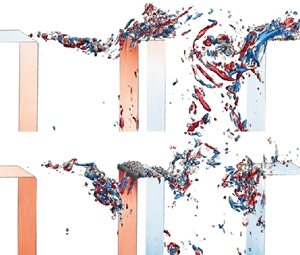Article contents
Flow–acoustic resonance mechanism in tandem deep cavities coupled with acoustic eigenmodes in turbulent shear layers
Published online by Cambridge University Press: 05 April 2024
Abstract

This study presents the interplay of flow and acoustics within tandem deep cavities, focusing on the resonance mechanism occurring between turbulent shear layers and acoustic eigenmodes. The arrangement inside the tandem deep cavities includes both close and remote configurations. A combined fully coupled and decoupled aeroacoustic simulation strategy was devised. Employing an advanced high-order spectral/hp element method in conjunction with implicit large eddy simulation, the nonlinear compressible Navier–Stokes equations were solved to acquire internal flow–acoustic resonant field. In parallel, the linearized Navier–Stokes equations were tackled to determine coherent shear layer perturbations with external acoustic forcing. Based on acoustic measurements, the mainstream Reynolds number approaches approximately  $R{e_{in}} = {O}({10^5})$, where we identified the presence of frequency lock-in and a resonance range. Aeroacoustic noise sources were examined by implementing spectral proper orthogonal decomposition to decompose the pressure fields into hydrodynamic and acoustic components. As feedback intensified, the flow characteristics by the acoustic forcing effect and the flow-interactive effect were categorized according to the development of concurrent turbulent shear layers. Subsequently, the alternating and synchronous behaviours of concurrent shear layers resonated with the out-of-phase and in-phase acoustic eigenmodes were identified, and the corresponding large-scale counter-rotating vortex pairs and co-rotating vortex structures at the cavity entrances were extracted. The acoustic power generated by the Coriolis force was calculated using Howe's vortex-sound analogy, and the aeroacoustic energy transfer mechanism between large-scale shear layer vortices with acoustic eigenmodes was further explored. Finally, a linear response of coherent perturbations of the concurrent shear layers by external acoustic forcing was established. The amplification of flow in the streamwise direction toward the main duct led to the formation of coherent vortex structures, accompanied by separation bubbles into the main duct.
$R{e_{in}} = {O}({10^5})$, where we identified the presence of frequency lock-in and a resonance range. Aeroacoustic noise sources were examined by implementing spectral proper orthogonal decomposition to decompose the pressure fields into hydrodynamic and acoustic components. As feedback intensified, the flow characteristics by the acoustic forcing effect and the flow-interactive effect were categorized according to the development of concurrent turbulent shear layers. Subsequently, the alternating and synchronous behaviours of concurrent shear layers resonated with the out-of-phase and in-phase acoustic eigenmodes were identified, and the corresponding large-scale counter-rotating vortex pairs and co-rotating vortex structures at the cavity entrances were extracted. The acoustic power generated by the Coriolis force was calculated using Howe's vortex-sound analogy, and the aeroacoustic energy transfer mechanism between large-scale shear layer vortices with acoustic eigenmodes was further explored. Finally, a linear response of coherent perturbations of the concurrent shear layers by external acoustic forcing was established. The amplification of flow in the streamwise direction toward the main duct led to the formation of coherent vortex structures, accompanied by separation bubbles into the main duct.
JFM classification
- Type
- JFM Papers
- Information
- Copyright
- © The Author(s), 2024. Published by Cambridge University Press
References
- 8
- Cited by



